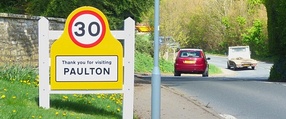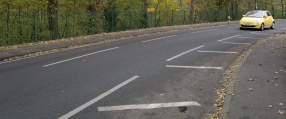Warning signs

Warning signs prepare drivers for hazards in the road ahead. The signs have an illustration of the hazard inside a red triangle, sometimes with additional wording underneath. They are especially useful where the hazard is not easily visible e.g. on narrow roads, or roads with bends.
Common examples of warning signs
Warning signs on fast roads
Bend warning signs inform drivers there is a sharp bend ahead. This is necessary when the severity of the bend is not immediately clear to the driver. These signs should encourage drivers to slow down so they can steer round the bend safely.
Junction warning signs prepare drivers to expect slow turning vehicles ahead, which they may need to slow down for.
Warning signs useful in rural areas
Signs warning of specific hazards in rural areas are also useful. These could include warnings for the presence of horse riders or for slow moving farm vehicles, for example.
Pedestrian and cycle warning signs
A separate page for pedestrian and cycle warning signs can be found here.

Disadvantages
- Drivers may not choose to change their speed in response to the signs
- Can be unsightly in conservation areas, and can 'urbanise' villages
- The signs will add to sign clutter
- If the signs are used too frequently, they can lose their effectiveness
Restrictions
- Not generally used in areas with a speed limit below 30 mph
- The likelihood of encountering the hazard must be high (in order to ensure the signs are not overused)
- There are many types of warning signs, however, they are limited to those contained within the Traffic Signs Regulations and General Directions
There's also some general restrictions to note for all schemes
Advantages
- A relatively low cost option
- Can work especially well on roads with poor visibility:
- Where roads are narrow
- Where bends could hide hazards
- On roads without street lighting during hours of darkness

Sign backing boards
Grey or yellow backing boards can help in making a sign more visible, especially if the sign is sited in amongst vegetation or on a skyline.
Yellow backing boards are the best way to make a warning sign more visible and they are generally only used where accidents are frequent. Yellow backing boards must not be overused however, otherwise they may lose their effectiveness. Grey backing boards may be used at other locations.
Backing boards are relatively low cost, and they can be used on any warning sign except STOP signs, which have a unique shape outline.

Effectiveness
This intervention doesn’t have any safety evidence available. Instead, likely outcomes are covered.
When vehicle drivers see a warning sign, they should reduce their speed for their own safety, and the safety of others. However, some drivers may take little notice of the hazard sign, and will continue at an unsafe speed.







